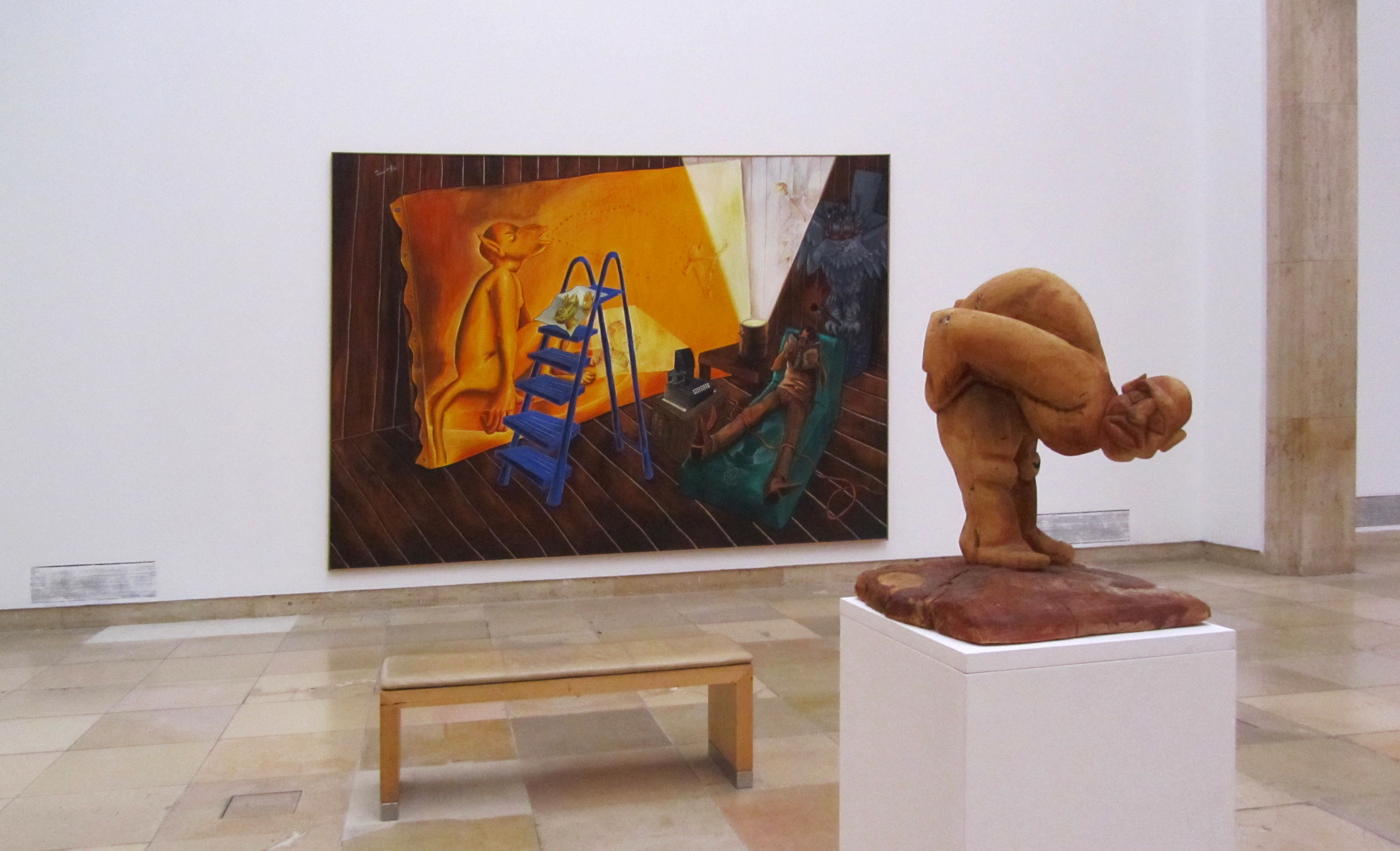
„Jörg Immendorff: For all Beloved in the World“ at Haus der Kunst, Munich
14. January 2019For all Beloved in the World is certainly not the show to see if you’re hoping for a nice, carefree afternoon – it’s too deep, too gloomy for that. This exhibition demands both cooperation and concentration from its visitors, partly because of the sheer number of pictures, and partly because the rooms are not easy to navigate. If there were an award for the most irritating accompanying booklet, the one for the Immendorff exhibition would win, hands down.
Ideally, you should read up about Immendorff before you come to the show, otherwise you could quickly feel overwhelmed. However, once you decide to go with the flow, it will probaby turn out to be one of those excellent exhibitions that is remembered for many years.
The team around curator Ulrich Wilmes has gathered together almost 200 paintings and sculptures, covering more than four decades, for the show. The works are presented in loosely chronological order, arranged in groups that represent different stages of his career.
The first two rooms contain mainly political works from the 1960s and 1970s. In the first room there are (among other things) a selection of his fat babies, with which Immendorff tried subtly to appeal to the good in mankind during the Vietnam War, whereas in room 2, the sense of the artist’s increasing politicisation is unmistakable. In 1969, Immendorff was expelled from Düsseldorf Academy of Fine Arts. In the period that followed, he primarily created agitation and propaganda images that reflected his socially critical views.
In the late 1970s, these pictorial themes gave way to motifs in which Immendorff dealt with the division of Germany. This eventually led to the beginning of his Café Deutschland series in 1978. Inspired by Renato Guttuso’s Caffè Greco from 1976, Immendorff shows artists, politicians, and other well-known personalities from both German states in ever-changing constellations, celebrating together in a sparsely lit bar. Other pictures, from the 1980s, show strangely vulnerable star-shaped masses that turn their badly healed wounds towards the viewer – and can easily be interpreted as a divided Germany.
After all the attention Immendorff paid to the subject, it is surprising that he does not seem to refer in any of his works to the fall of the Berlin Wall in 1989, and the subsequent reunification of Germany.
Another group of works comprises several monkey sculptures that Immendorff created between 2002 and 2007. The artist calls them Malerstamm (tribe of painters). Each of the bronzes is a homage to a great painter from history and from the present. As early as 1985, the figure of the monkey appeared in the artist’s paintings, and could be interpreted in a variety of ways. It could be representing anything – desire, irony, friend or enemy.
In 1997, Immendorff was diagnosed with amyotrophic lateral sclerosis (ALS). This degenerative disease of the nervous system ultimately forced him to develop image ideas that could be transferred to assistants as the disease progressed.
In terms of subject matter, his late work increasingly dealt with themes such as transformation, transience and – unsurprisingly – his own mortality. This can be experienced impressively in two paintings: Letztes Selbstporträt I – das Bild ruft (Last Self-Portrait I – The Picture Calls) from 1998, which shows him in a dark room illuminated only by a candle. Motionless, he sits at a table. The melancholy is almost physically perceptible.
Selbstporträt nach dem letzten Selbstporträt (Self-Portrait after the last Self-Portrait) from 2007 takes up the same motif. Whereas in the earlier picture he dealt with the beginnings of his illness, the later one is a work carried out by assistants. Immendorff died that same year.
Again and again there were (and probably will continue to be) discussions about the authenticity of Jörg Immendorff’s late work. He could no longer execute most of these works himself, but they were realised according to his precise instructions. What is the norm for sculptors, architects and installation artists is criticised in painting. Of course you can do that, but doesn’t it deny the artist the right of his art as a concept?
Jörg Immendorff: For all Beloved in the World, Haus der Kunst in Munich, 14.09.18 — 27.01.19
